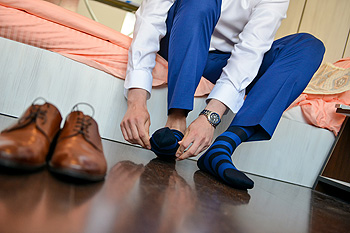
The shoes you wear play an important role in the health of your feet. Improperly fitting shoes can contribute to the development of corns, calluses, bunions, and hammertoes. Besides reducing the pain from a foot deformity or gait problem, well-fitted shoes can also help prevent these conditions from becoming worse. Following are a few ways to increase the chances of finding the right shoe for your feet. Try on shoes at the end of the day, when your feet will be the largest. Bring with you any orthotics you may need, as well as the socks or foot coverings you are likely to wear with that shoe. Have your feet measured, and if one foot is larger, choose that size. Stand in the shoes, and walk around a bit to see how they feel. If the shoe is too tight or too loose in the store, try a different size or a different style. Look for shoes with ample room in the toe box, and avoid high heels. Also look for shoes with mesh uppers that allow the feet to breathe and those that provide cushioning to the heel and ball of the foot. If you have preexisting conditions of the feet, it is a good idea to seek the guidance of a podiatrist before purchasing your footwear.
Finding a properly-fitting shoe is important in reducing injuries and preventing foot problems. For more information about treatment, contact Dr. Richard DiMario from Maine. Our doctor will treat your foot and ankle needs.
Proper Shoe Fitting
A common concern when it comes to foot health, having properly fitted shoes can help prevent injuries to the foot. Out feet affect our posture and gait, which in turn affects the biomechanics and overall bodily structure. With 33 joints, 26 bones, and over 100 ligaments, the potential for serious injury is much greater than one realizes. Although the feet cease growth in adulthood, they still change shape as they mature. Here are some factors to consider when it comes to investing in proper fitting shoes:
Keeping in mind how shoes fit the biomechanics of your body, properly-fitting shoes are vitally important. Fortunately, it is not difficult to acquire footwear that fits correctly. Be sure to wear shoes that support the overall structure of your body. Do your feet a favor and invest in several pairs of well-fitted shoes today.
If you have any questions please feel free to contact our office located in York, ME . We offer the newest diagnostic and treatment technologies for all your foot and ankle needs.
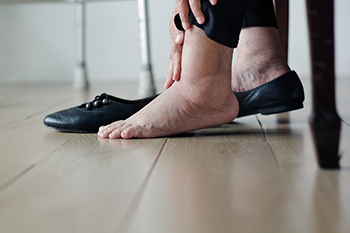
Swelling around the ankles is nothing to ignore. When one’s ankles become swollen, one can feel tight and restricted, making it significantly difficult to walk and wear shoes that would otherwise fit comfortably. Swelling can occur for any number of reasons. Commonly, pregnancy can make one’s feet swell because of the extra blood and fluids that a pregnant woman produces to support the growing baby. Additionally, your feet and ankles may swell in response to some kind of injury to your feet, ankles, or lower legs. Whatever the cause of your swollen ankles, there are a variety of steps that you might consider taking to mitigate the effects of your swollen ankles. Perhaps you might benefit from wearing compression socks or stockings. These stockings are made to put pressure on your feet, which has the effect of facilitating blood circulation and discouraging fluid from gathering in the feet. Besides wearing compression socks, you might also consider washing your feet and ankles in Epsom salts. This is done to increase magnesium levels, which can have the effect of minimizing inflammation. Lastly, a very common technique that is used to mitigate swollen feet and ankles is to elevate the feet to promote circulation. If you are concerned about your swollen feet, consider reaching out to a podiatrist.
Swollen feet can be a sign of an underlying condition. If you have any concerns, contact Dr. Richard DiMario of Maine. Our doctor can provide the care you need to keep you pain-free and on your feet.
Swollen feet are a common ailment among pregnant women and people who stand or sit for extended periods. Aging may increase the possibility of swollen feet and patients who are obese often notice when their feet are swelling too. There may be medical reasons why swollen feet occur:
Swollen feet can also be caused by bone and tendon conditions, including fractures, arthritis, and tendinitis. Additionally, there may be skin and toenail conditions and an infection may cause the feet to swell. Patients who take medicine to treat high blood pressure may be prone to getting swollen feet.
Many patients elevate their feet to help relieve the swelling and this is generally a temporary remedy. When a podiatrist is consulted the reason behind the swelling can be uncovered and subsequently treated.
If you have any questions please feel free to contact our office located in York, ME . We offer the newest diagnostic tools and technology to treat your foot and ankle needs.
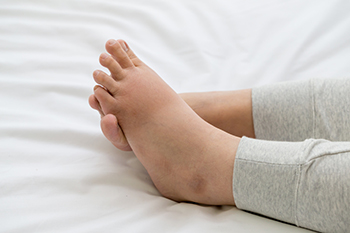
The main issue of pregnancy affecting a woman’s feet and ankles is swelling or edema. Unfortunately, this is common and results due to hormonal changes, the production of extra blood during pregnancy, fluid retention, and circulation problems. The degree of swelling one will experience depends on various factors, such as the season of pregnancy, length of time spent on one’s feet, tightness of clothing or shoes, and time of day. Increases in progesterone slow down digestion which can lead to more fluid being absorbed in the large intestine and fluid retention. This hormone also slows down circulation and relaxes blood vessels making it easier for fluid to build up in the feet. Edema in pregnancy usually happens during the 3rd trimester, however, it can start earlier depending on the other factors discussed above. Often the swelling will continue until after birth and goes away within a few days or weeks after delivery. There is generally nothing to worry about with this type of swelling but sometimes it can signal more serious complications, like preeclampsia or deep vein thrombosis. If you have any questions as to what is normal with edema in the lower extremities during pregnancy, consult with a podiatrist who can diagnose any abnormal conditions or set your mind at ease.
Pregnant women with swollen feet can be treated with a variety of different methods that are readily available. For more information about other cures for swollen feet during pregnancy, consult with Dr. Richard DiMario from Maine. Our doctor will attend to all of your foot and ankle needs.
What Foot Problems Can Arise During Pregnancy?
One problem that can occur is overpronation, which occurs when the arch of the foot flattens and tends to roll inward. This can cause pain and discomfort in your heels while you’re walking or even just standing up, trying to support your baby.
Another problem is edema, or swelling in the extremities. This often affects the feet during pregnancy but tends to occur in the later stages.
How Can I Keep My Feet Healthy During Pregnancy?
If you have any questions please feel free to contact our office located in York, ME . We offer the newest diagnostic and treatment technologies for all your foot and ankle needs.

Many people undergo foot surgeries when all other options for have failed. There are several types of foot surgery, which can be successful for permanent relief. An Achilles tendon rupture may require surgery, and this is accomplished by having a 3-inch incision cut at the back of the ankle where the tendon has ruptured. The tendon is sewn together with sutures. After closing the wound, the foot is typically placed in a protective boot as the healing process occurs. Bunion surgery is another common form of foot surgery. A bunion is a bony protrusion of the big toe that can develop from genetic factors or wearing shoes that are too tight. If the bunion becomes painful and completing daily activities becomes difficult, joint fusion may be a viable option. It is done by fusing the joint of the big toe. Another alternative may be to have a joint replacement performed. If you are considering any type of foot surgery, it is strongly advised that you are under the care of a podiatrist who can determine if you are a candidate.
Foot surgery is sometimes necessary to treat a foot ailment. To learn more, contact Dr. Richard DiMario of Maine. Our doctor will assist you with all of your foot and ankle needs.
When Is Surgery Necessary?
Foot and ankle surgery is generally reserved for cases in which less invasive, conservative procedures have failed to alleviate the problem. Some of the cases in which surgery may be necessary include:
What Types of Surgery Are There?
The type of surgery you receive will depend on the nature of the problem you have. Some of the possible surgeries include:
Benefits of Surgery
Although surgery is usually a last resort, it can provide more complete pain relief compared to non-surgical methods and may allow you to finally resume full activity.
Surgical techniques have also become increasingly sophisticated. Techniques like endoscopic surgery allow for smaller incisions and faster recovery times.
If you have any questions please feel free to contact our office located in York, ME . We offer the newest diagnostic and treatment technologies for all your foot and ankle needs.
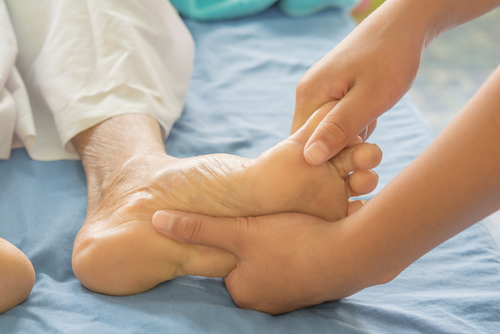
A popular form of foot therapy is a foot massage. Many people who have foot pain reap the benefits of getting a foot massage. These can include improved circulation, and relief of stress and pain, in addition to releasing muscle tension. Reflexology started in traditional Chinese medicine, and it is an effective form of foot therapy. It is commonly used to help cancer patients. This is done by touching the feet at specific pressure points and this can create an overall feeling of well-being. This can also stimulate the nervous system and positively affect energy flow. People who have regular reflexology and massage sessions may experience better sleeping patterns, lower blood pressure, and possibly diminished psychological and physical pain. Many people enjoy additional forms of foot therapy, including having a Swedish massage, shiatsu, or Thai massage performed. Massages and reflexology sessions begin by removing the shoes and socks and asking the patient if there are specific areas of pain. If you would like to know more about the benefits of foot massages and reflexology, please consult with a podiatrist who can answer any questions you may have.
Foot therapy is often necessary for those recovering from either foot deformities or foot injuries. If you have concerns regarding therapy, consult with Dr. Richard DiMario from Maine. Our doctor can provide the care you need to keep you pain-free and on your feet.
Most Common Injuries
People who are active or athletes are prone to a variety of injuries. Therefore, it is often important to take part in physical therapy in order to quickly get back on the right track.
What to Do When Injured
Physical Therapy – This specialized treatment will focus on the affected area, speeding up recovery and the overall healing process. It is a proven method that has helped millions of people return from any injury.
During physical therapy you will undergo regimented training to get back into full form. Training is often very difficult, especially at first when the foot feels weak. Physical therapy often involves:
Basic stretching and twisting exercises – getting the feet’s mobility and flexibility up.
Massaging – the therapist will massage the injured area in order to activate the muscles and relax them.
Strengthening Exercises – this allows the muscles in the affected area to regain their full strength, a vital step towards full recovery.
If you have any questions please feel free to contact our office located in York, ME . We offer the newest diagnostic tools and technology to treat your foot and ankle needs.

There are many people who have jobs that require standing and working on their feet. Foot pain is a common ailment among people who are in this category and it can be reduced or diminished when the proper footwear is worn. It is beneficial to wear a shoe with a small heel and weakness and soreness can be reduced when work shoes have proper arch support. It is important that shoes fit correctly as this may prevent poor circulation and blisters from developing. Some people choose to wear compression socks, which can be helpful in reducing blood flow to the feet, and redirecting it toward the heart. When the workday is finished, the feet will feel better when they are soaked in cold water followed by massaging them. This is beneficial in reducing inflammation and swelling that can happen during the work day. If you would like additional information about how your feet can feel better at the end of the day, please speak with a podiatrist who can offer you effective foot care tips.
While working on the feet, it is important to take the proper care of them. For more information about working on your feet, contact Dr. Richard DiMario from Maine. Our doctor will treat your foot and ankle needs.
Working on Your Feet
Standing on your feet for long periods of time can cause stress and pain in your feet. Your whole body may experience change in terms of posture, back pain, bunions, callouses and or plantar warts. There are ways to avoid these conditions with proper foot care, smart choices and correct posture.
Positive Changes
Negative heeled shoe – Choosing this shoe type places the heel slightly lower than the ball of the foot. These are great for overall foot health. Find shoes that fit you correctly.
Go barefoot – Our feet were not designed to be enclosed for all hours of the day. Try to periodically expose your feet to air.
Eliminate Pain
Foot Exercises – Performing simple exercises, incorporating yoga and doing stretches are beneficial. This will allow increased blood flow to the area and muscles of the foot.
Achilles tendon – Stretching the foot out flat on the floor will relax the calf muscles and tendon. These exercises can be performed almost anywhere. Make sure you add these exercises to your daily regimen.
With a little bit of this information and knowing more about foot health, you will notice changes. Foot stretches and proper footwear will help with pain and prevent further issues.
If you have any questions please feel free to contact our office located in York, ME . We offer the newest diagnostic and treatment technologies for all your foot and ankle needs.
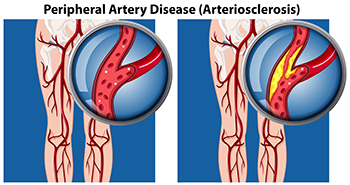
About 6.5 million people in the United States over the age of 40 have peripheral artery disease (PAD). It is a blockage in the arteries that supply blood to the extremities, but the condition is more common in the feet and lower limbs. Risk factors for peripheral artery disease include smoking, high blood pressure, diabetes, atherosclerosis, and high cholesterol. People over 60 are at further risk. The most common symptom of PAD is pain in the legs while active, but that subsides after resting. Sores in the legs or feet that don’t heal and cold or numb toes are other symptoms as well. If you believe you may have PAD, please consult a podiatrist for an examination and testing.
Peripheral artery disease can pose a serious risk to your health. It can increase the risk of stroke and heart attack. If you have symptoms of peripheral artery disease, consult with Dr. Richard DiMario from Maine. Our doctor will assess your condition and provide you with quality foot and ankle treatment.
Peripheral artery disease (PAD) is when arteries are constricted due to plaque (fatty deposits) build-up. This results in less blood flow to the legs and other extremities. The main cause of PAD is atherosclerosis, in which plaque builds up in the arteries.
Symptoms
Symptoms of PAD include:
It is important to note that a majority of individuals never show any symptoms of PAD.
Diagnosis
While PAD occurs in the legs and arteries, Podiatrists can diagnose PAD. Podiatrists utilize a test called an ankle-brachial index (ABI). An ABI test compares blood pressure in your arm to you ankle to see if any abnormality occurs. Ultrasound and imaging devices may also be used.
Treatment
Fortunately, lifestyle changes such as maintaining a healthy diet, exercising, managing cholesterol and blood sugar levels, and quitting smoking, can all treat PAD. Medications that prevent clots from occurring can be prescribed. Finally, in some cases, surgery may be recommended.
If you have any questions, please feel free to contact our office located in York, ME . We offer the newest diagnostic and treatment technologies for all your foot care needs.

The feet carry the weight of the body so it is important to take proper care of them. One of the best things you can do for your feet is stretch them frequently. This helps maintain flexibility and range of motion. A stretch that can help the plantar fascia is performed by practicing a foot roll. This is done by placing your foot on top of a golf ball and rolling it back and forth. People who stand for the majority of the day also find this to be an effective foot stretch. The toes can become stronger when toe stretches are done, and this can positively affect the overall foot. Additionally, a towel lift is good for the toes and middle of the foot. This is done by placing a towel on the floor while sitting in a chair and lifting the towel with the toes. The heels can benefit from standing on a step and lowering the heels one at a time until a gentle stretch is felt. If you would like more information about the benefits of stretching the feet and additional stretches to practice, please consult with a podiatrist.
Why Stretching Is Important for Your Feet
Stretching the feet is a great way to prevent injuries. If you have any concerns with your feet consult with Dr. Richard DiMario from Maine. Our doctor will assess your condition and provide you with quality foot and ankle treatment.
Stretching the Feet
Stretching the muscles in the foot is an important part in any physical activity. Feet that are tight can lead to less flexibility and make you more prone to injury. One of the most common forms of foot pain, plantar fasciitis, can be stretched out to help ease the pain. Stretching can not only ease pain from plantar fasciitis but also prevent it as well. However, it is important to see a podiatrist first to determine if stretching is right for you. Podiatrists can also recommend other ways to stretch your feet. Once you know whether stretching is right for you, here are some excellent stretches you can do.
It is best to go easy when first stretching your foot and work your way up. If your foot starts hurting, stop exercising to ice and rest the foot. It is advised that you then see a podiatrist for help.
If you have any questions, please feel free to contact our office located in York, ME . We offer the newest diagnostic and treatment technologies for all your foot care needs.